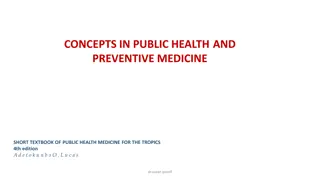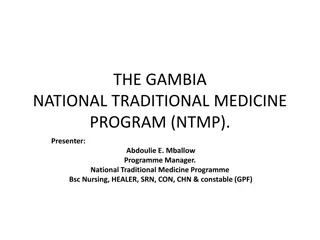Evolution of Medicine: A Historical Journey Through the Ages
Explore the rich history of medicine from ancient times to the modern healthcare system. Discover the evolution of healthcare practices, from natural remedies and spiritual beliefs to the rise of medical regulation and scientific advancements that revolutionized the field of medicine.
Download Presentation

Please find below an Image/Link to download the presentation.
The content on the website is provided AS IS for your information and personal use only. It may not be sold, licensed, or shared on other websites without obtaining consent from the author.If you encounter any issues during the download, it is possible that the publisher has removed the file from their server.
You are allowed to download the files provided on this website for personal or commercial use, subject to the condition that they are used lawfully. All files are the property of their respective owners.
The content on the website is provided AS IS for your information and personal use only. It may not be sold, licensed, or shared on other websites without obtaining consent from the author.
E N D
Presentation Transcript
Medicine has been around for thousands of years. Hippocrates is known as the father of Western medicine as far back as the 4thcentury B.C. The healthcare system as we know it is much younger with advancements in technology and better understanding of diseases and medications todays medicine is roughly just 50 years old Medicine has been practiced in some form or another since humans have been living. Different cultures believed in different ways of treating illness, some believed that sickness was a result of the moods of the gods, others tried to use reasoning to explain sickness
Healers in ancient times used natural remedies like diets, rest, and medicines made from herbs and plants. Religion has always been a big part of healthcare. The symbol we use today is linked with ancient times the Greek god of healing was symbolized by the snake. This evolved into what today we know as the caduceus
Period from A.D. 500-1500 Reason began to replace spiritual or superstitious causes for illness Barbers cut more than hair in the middle ages. Known as Barber- surgeons, they performed surgery to treat cataracts, and practiced phlebotomy. Many served in military and treated injuries Amputated limbs with burned stumps to seal blood vessels The barber pole we see today looks similar as it did in this time period when Barbers would do an operation the bandages would be hung on a pole and sometimes placed outside as an advertisement
Medical regulation began in the middle ages Physicians were licensed after training with experienced doctors Difference between physician and surgeons Women weren t allowed to practice medicine Religion continued to play a big role in medicine with many religious leaders calling for the care of the sick and dyeing
Medical practice went through many changes The invention of the printing press made it possible to publish books faster thus spreading knowledge faster and made it more readily available During the 16thcentury the scientific method came into use, this changed the way people thought about medicine This allowed the acquisition of new knowledge Instead of using guess work or supernatural events to explain diseases, people began to look for the cause based on what they could see around them
Scientific method based on observation and taking careful notes, this was not common in the Middle Ages The microscope was invented which allowed observation of clients and symptoms Robert Hooke built one of the first microscopes
During the Industrial Revolution medicine experienced huge advancements The stethoscope was introduced, as well as the microscope This allowed for visualization of blood cells, bacteria, and protozoa Doctors realized that blood was carried through the body by large vessels but they didn t understand how it circulated through the body this of course was explained with the discovery of capillaries
Edward Jenner (1749-1823) helped make the connection between health and the environment. Jenner discovered that milkmaids exposed to cowpox did not get smallpox . In 1796 he began inoculating people and thus vaccinations were born Louis Pasteur (1822-1895) Father of microbiology Joseph Lister (1827-1912) was ridiculed for insisting people use soap to disinfect instruments and clean hands before the Doctor moved from one Pt to another Today this is known as medical asepsis and is the stand of care today
Robert Koch (1843-1910) discovered that pathogens(disease causing microbes) are the source of some diseases and proved that Lister was correct in his recommendations This ushered in the era or modern microbiology and the use of anesthetic thus making surgery possible
20thcentury had rapid growth with discoveries in electronics and computer science changed clinical medicine Antibiotics were invented, Radium for cancer treatments, X-rays gained importance in diagnoses Axial tomography(CT scan), magnetic resonance imaging(MRI), and ultra sound or sonographic imaging had improved diagnosis and treatment for many diseases
Today organ transplants are common. Research has found a way to grow certain body systems artificially In vitro fertilization allows couples to have children when they are infertile Todays healthcare workers need to be able to think critically and be flexible with approaches in Pt care and treatment. The field has and will continue to be forever changing and adapting to todays fast paced world
Ambulatory Care and Outpatient Surgery- these are facilities where the Pt can simply walk in the morning for a procedure and walk out that afternoon(out Pt) Home Health Care- a member of a healthcare team comes out to a Pt residence and does in home care for that Pt Hospitals-Pt typically require closer monitoring and care for an extended period of time Religious, Private, and Nonprofit Hospitals Long term care(nursing homes/assisted living)- typically an environment were Pt live full time. In certain instances this could be weeks during a rehab assignment or a permanent arrangement
Other medical components to the healthcare system are Practitioner's offices Clinics Laboratories Emergency Medical Services(EMS) Rehabilitation Hospice
Number of deaths and births in a nation affect the overall age of its population The median is 37.1 y/o Males 35.8 y/o Females 38.5 y/o In 1980 the median ages were as followed Median Age 30.0 Males 28.8 Females 31.3
Medicare- provides health insurance to people 65 y/o and older, and those who are disabled Medicaid- health insurance for low income people also included are the elderly, blind, disabled on government income, low income pregnant women, and certain people with low income and high medical expense Managed Care-specifies specifically what and how much a person can spend on a certain procedure Worker s Compensation- if a person is hurt doing their job the company they are working for has to pay for medical expenses
Preventive care- bp and ca screenings Primary care(health promotion)- prenatal care, family planning, daily exercise Secondary Acute Care- emergency care, radiological procedures Tertiary Care- intensive care Restorative care- cardio/pulmonary rehab Continuing care- assisted living
Competency-Ongoing CEU, and furthering ones education is necessary in today s healthcare field Evidence-Based Practice-the integration of best knowledge, which includes clinical expertise, best research evidence, and Pt values Quality Health Care- The level of care we provide our Pt s and the level of care the Pt feels is different and needs to be equal on both sides Pt satisfaction- it is important that the level of care we provide meets or exceeds the Pt s expectations while receiving services



























